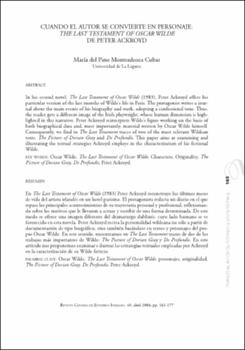Cuando el autor se convierte en personaje: The Last Testament of Oscar Wilde de Peter Ackroyd
Date
2004Abstract
En The Last Testament of Oscar Wilde (1983) Peter Ackroyd reconstruye los últimos meses
de vida del artista irlandés en un hotel parisino. El protagonista redacta un diario en el que
repasa los principales acontecimientos de su trayectoria personal y profesional, reflexionando
sobre los motivos que le llevaron a actuar y escribir de una forma determinada. De este
modo se ofrece una imagen diferente del dramaturgo dublinés, cuyo lado humano se ve
favorecido en esta novela. Peter Ackroyd recrea la personalidad wildeana no sólo a partir de
documentación de tipo biográfico, sino también basándose en textos y personajes del propio
Oscar Wilde. En este sentido, encontramos en The Last Testament trazos de dos de los
trabajos más importantes de Wilde: The Picture of Dorian Gray y De Profundis. En este
artículo nos proponemos examinar e ilustrar las estrategias textuales empleadas por Ackroyd
en la caracterización de su Wilde ficticio. In his second novel, The Last Testament of Oscar Wilde (1983), Peter Ackroyd offers his
particular version of the last months of Wilde’s life in Paris. The protagonist writes a journal
about the main events of his biography and work, adopting a confessional tone. Thus,
the reader gets a different image of the Irish playwright, whose human dimension is highlighted
in this narrative. Peter Ackroyd reinterprets Wilde’s figure working on the basis of
both biographical data and, most importantly, material written by Oscar Wilde himself.
Consequently, we find in The Last Testament traces of two of the most relevant Wildean
texts: The Picture of Dorian Gray and De Profundis. This paper aims at examining and
illustrating the textual strategies Ackroyd employs in the characterization of his fictional
Wilde.






